 |
||
|
||
| ||
GlacialTech is well known and popular on our market. The company managed to solve the problem that faces all manufacturers of cooling equipment: thermal effectiveness is well combined with a low noise level and moderate prices. Such a considerable achievement wasn't unnoticed - the work done by GlacialTech yielded ample harvest. Just look at the Igloo 2310 which combines interesting functions earlier unachievable for budget coolers. The Igloo Silent Breeze impressed us with its record-breaking quietness. The Igloo 2500 Pro that managed to successfully stand against the powerful Thermaltake Volcano 7+ keeps on bringing excellent scores. The progress doesn't slow down, and the requirements it puts forward do not get softer. Fortunately, it's not typical of GlacialTech to leave things as is or do nothing for further progress. The Igloo family recently got 9 new models for the Socket A (5 budget-level solutions plus 4 high-end ones). Will they be able to maintain high performance level their predecessors reached? Let's see! Igloo 2411 and Igloo 2420
 GlacialTech Igloo 2411 & Igloo 2420 Igloo 2411, an extension of the budget Igloo 2310 looks minute because of the small-sized aluminium heatsink (73x63x28 mm) and the pretty slow fan (70x70x15 mm). But the cooler has a very strong point - a trapezoid fin which is traditional for GlacialTech. In terms of thermal effectiveness its parameters (0.6 mm base width and 0.3 mm on top) are close to an ideal fin with the constant heat flux making heat removal from the fins more effective. 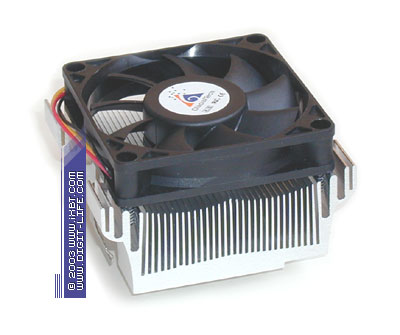 High efficiency is achieved at the expense of denser and shorter fins (1 mm fin step, 20 mm average fin height). The overall heat exchange surface is pretty large (about 900 sq cm), but it doesn't increase the heatsink flow resistance much. All it lets the Igloo 2411 demonstrate acceptable thermal effectiveness. The cooler has a convenient base size and a tool-free mounting for quick and flawless installation of the Igloo 2411 on almost all Socket A mainboards. Like all GlacialTech products this one also comes with the preinstalled thermal interface (a clone of the Dow Corning 340). The Everflow R127015DL fan (3000 rpm) also looks nice - it contains a good combined bearing (one ball and one sleeve), a good two-phase inductor and a well balanced impeller. 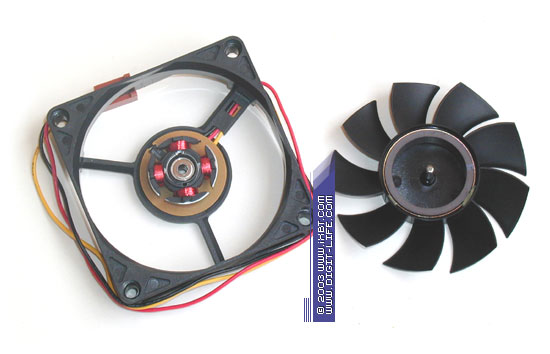 The Igloo 2411 doesn't lose its chance to show brilliant scores. It's far ahead of the Igloo 2310, leaves behind the Evercool ND15-715 and Titan TTC-D5TB(TC), and yields a bit only to the other GlacialTech's veteran - Igloo 2410. At the same time the Igloo 2411 doesn't make much noise (34 dBA). The second junior is Igloo 2420: its design is similar to the Igloo 2411 but it's equipped with the bigger fan (70x70x25 mm) that rotates at the speed of 3,000 rpm (Everflow R127025DL). Due to its more powerful fan (that delivers a faster air flow and greater static pressure) the Igloo 2420 outdoes the Igloo 2411 in thermal effectiveness and goes on a par with the Igloo 2410. At the same time, the noise level is higher (35 dBA). In general, taking into account the noise/effectiveness balance the Igloo 2420 and Igloo 2411 perform similarly. Igloo 2450 Light, Igloo 2450 & Igloo 2450 Pro The next three budget-level models are Igloo 2450 Light, Igloo 2450 and Igloo 2450 Pro; they extend the Igloo 2410 line. They are based on similar aluminium heatsinks (73x64x40 mm), equipped with fans measuring 70x70x25 mm and ranged according to the impeller speed (2200, 3000 and 4200 rpm respectively). 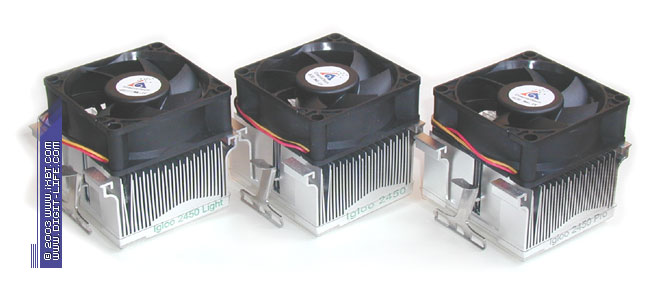 GlacialTech Igloo 2450 Light, Igloo 2450 & Igloo 2450 Pro As compared to the Igloo 2411/2420, brothers Igloo 2450 look more solid and reveal a fundamental technical potential. The cooler has two catalysts of thermal effectiveness which the Igloo 2410 also had - traditional trapezoid fins (0.7 mm base width and 0.3 on top) and alternating fin heights - they improve thermal properties of the fins and optimize sink's hydraulics. 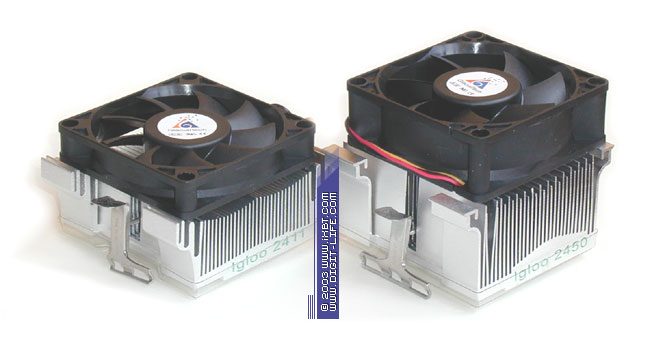 GlacialTech Igloo 2411 & Igloo 2450  GlacialTech Igloo 2410 & Igloo 2450 The Igloo 2450 has one more interesting feature: the sink base is thicker in the center which reduces the effect from resistance to heat flow spreading (it affects big all-aluminum heatsinks in greater extent). The general finning design is denser and thermally reinforced (1.2 mm fin step against 1.5 mm in the Igloo 2410, the heatsink has 29 working fins against 26 of the Igloo 2410). It makes these coolers superior to the good old Igloo 2410. 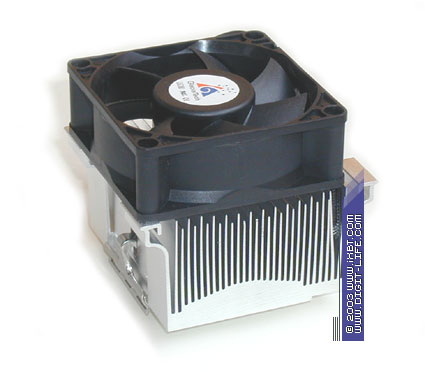 In spite of the large dimensions the base geometry looks very handy in installation and prevents any possible problems even on complicated boards. In addition, the advanced 6-pin mount of the tool-free design makes installation very simple. The excellent health is demonstrated by the fans the Igloo 2450 Light, Igloo 2450 and Igloo 2450 Pro are equipped with (Everflow R127025DL and R127025DM). They leave a good impression thanks to the combined bearing, two-phase inductor, steering circuit and aerodynamically optimized impeller. 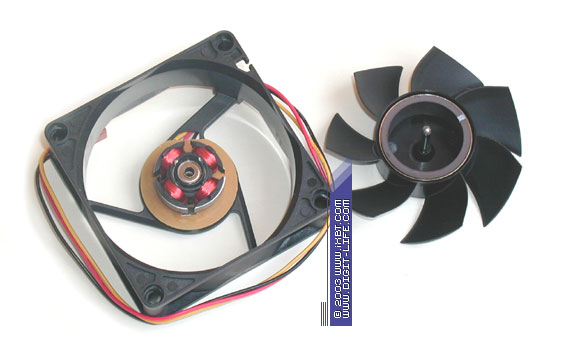 The Igloo 2450 coolers do their best to prove our forecasts. The Igloo 2450 Pro looks best of all - it jumps into the group of leaders and beats the Igloo 2410 Pro and many other strong competitors; plus, it works pretty quietly (44 dBA). The Igloo 2450 runs well as well. It outperforms the Igloo 2410 and easily catches up with the advanced box-type cooler, as well as other models of its level. The Igloo 2450 Light also makes a good showing. This silent model is as effective as the Igloo 2410; actually, it has every chance to take one of the most privileged places in today's world of low-noise coolers. The Igloo 2450 coolers show that the outcome depends not only on material a cooler is made of! The key factors are finning design and a balance of parameters. Technologies and materials are less important. The competent approach to the development of the Igloo 2450 coolers allowed them perform so well. Igloo 2510 & Igloo 2510 Pro Now come two high-end coolers - Igloo 2510 and Igloo 2510 Pro, followers of the successful fast runners Igloo 2500/Pro. 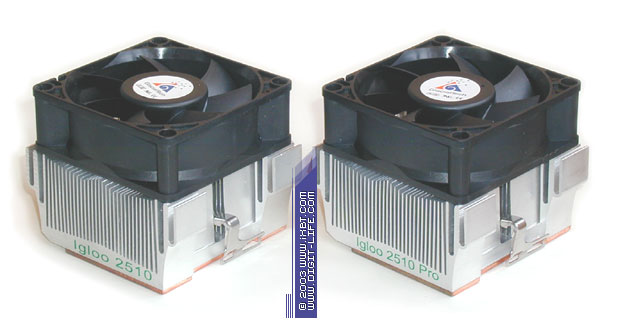 GlacialTech Igloo 2510 & Igloo 2510 Pro  GlacialTech Igloo 2500 Pro & Igloo 2510 Pro From the very beginning the coolers look very promising. The impressive heatsink (70x63x40 mm) with the advanced fin parameters, the fan measuring 70x70x25 mm and the user-friendly 4-pin mount make them very powerful. They also have trapezoid fins (0.6 mm base width and 0.3 mm on top) that form a dense and thermally reinforced finning (27 mm average fin height, 1mm step) inherited from the Igloo 2411/2420 and improved. 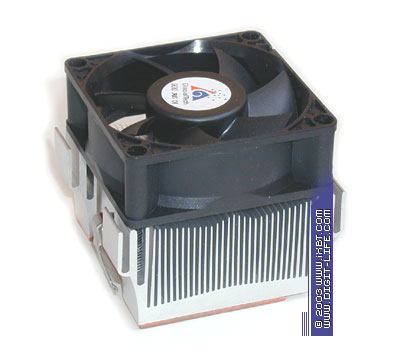 The new-comers took from the Igloo 2500/2500 Pro a copper plate (70x50x2 mm) attached to the base with the new patent fab process and intended to optimize heat distribution from the core and minimize the negative effects of resistance to the heat flow spreading. 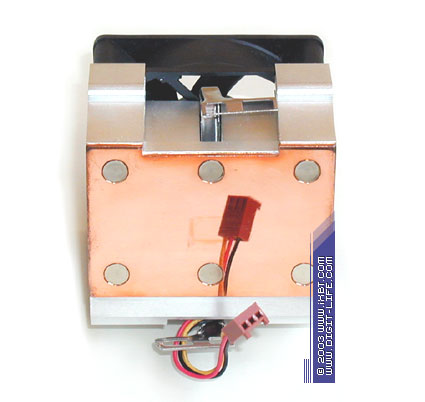 The polished surface looks almost like mirror. However, this helps just a little because the contact thermal resistance between the core and sink depends more on precision of the heatsink base flatness. Brilliant polishing of this surface is not that important in fact. But this doesn't belittle dignity of this cooler because it has no problems with the base-plate flatness and its processing quality. :) The Igloo 2510/2510 Pro coolers make a good showing as well. In spite of the solid sink the total cooler weight doesn't exceed the standards (it makes 290 g), and the heatsink can be easily pressed to the core. The sink base is well designed and there mustn't be any problems with its installation on mainboards. The Igloo 2510/2510 Pro are equipped with the same fans the Igloo 2450/2450 Pro have - Everflow R127025DL and R127025DM (3000 and 4200 rpm) which demonstrate decent electromechanic and quite good aerodynamic parameters. Models Igloo 2510/2510 Pro achieve good scores in this round. The Igloo 2510 Pro is almost the most effective cooler here (it beats even the Igloo 2500 Pro) and loses only to the champion Cooler Master Aero 7+. Noise it produces is not that high; the cooler has even better ergonomics compared to the Igloo 2500 Pro. The Igloo 2510 also looks good but it doesn't improve results of the Igloo 2500, and its noise is even greater by 2 dBA. On the other hand, the Igloo 2510 beats a lot of other strong competitors both in effectiveness and ergonomics. Silent Breeze 462 II & Diamond 2100 Finally, we have high-end GlacialTech's coolers named Silent Breeze 462 II and Diamond 2100. The heatsink of the Silent Breeze 462 II is gold-plated which makes it looking very stylish. Such a good combination of a real sportsman and an elegance is a rare thing. :) 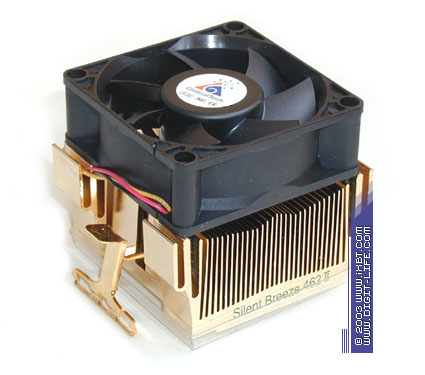 GlacialTech Silent Breeze 462 II Usually, such a noble appearance doesn't go with record breaking. But if you look closer at the Silent Breeze 462 II, you will see that it's a very interesting device. Thermal parameters are not sacrificed to the exterior: the heatsink of the Silent Breeze 462 II reminds those of the Igloo 2510/2510 Pro which already made a good showing. It has the same trapezoid fins, dense finning, a copper plate of the same dimensions and well processed surface, and the proprietary interface.  The low-noise fan (Everflow R127025DL, 2200 rpm), normative weight, optimized base parameters and convenient 6-pin mount make the Silent Breeze 462 II a good sportsman. Indeed, the cooler performs excellently - it takes the baton from the Igloo Silent Breeze 462 and easily outruns its competitors; it also demonstrates a good noise/performance balance and takes one of the highest positions in low-noise sector. The Silent Breeze 462 II is a worthy follower of the Igloo Silent Breeze 462. 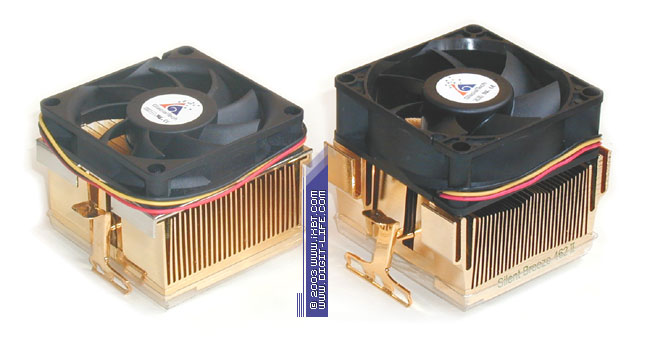 GlacialTech Igloo Silent Breeze 462 & Silent Breeze 462 II The other high-end product - Diamond 2100 - looks more modest. Its heatsink is also gold-plated, but its design is identical to the low-profile Igloo 2411/2420 and doesn't let it perform as efficient as the Silent Breeze 462 II. 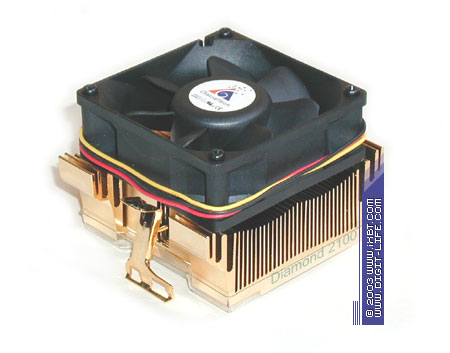 GlacialTech Diamond 2100 The best advantage of this cooler is its low-key and attractive appearance and its fan (Bi-Sonic BS702512MT) which integrates the control circuit that linearly regulates the impeller speed from 2200 to 3400 rpm in the temperature range from 30°C to 40°C. The Diamond 2100 perfectly controls its parameters depending on the load, and reaches a good noise/performance balance. In all other respects it looks similar to the Igloo 2420: it has a convenient mount, nice heatsink base parameters, and the fan of excellent electromechanical and aerodynamical quality. In the typical conditions it performs similarly to the latter. Before we give the finishing touches to our heroes let's have a look at their test scores. Test resultsLet's start with testing the thermal effectiveness. Testbed:
The CPUBurn burnk7 utility is used to emulate the thermal load close to
the maximum, and the Motherboard Monitor is used for temperature monitoring.
Note NoteFinally, here are the noise measurement results (the technique is described in the article Coolers noise characteristics and noise level measurement technique). Note: The background noise is ConclusionThe updated line of GlacialTech coolers successfully passes our benchmarks, takes the baton from the old Guards and honorably maintains its high level. The best looking "person" is the Silent Breeze 462 II which offers a complete set of features including excellent appearance, pleasant ergonomics and good efficiency. The Igloo 2510 Pro also shows excellent performance and takes one of the top positions. The budget-level Igloo 2450 coolers have a nice combination of the consumer features and can be awarded the Best Product title in their class. We'd like to thank GlacialTech and wish them further success in developing
high-performace solutions at moderate prices.
Vitaly Krinitsin (vit@ixbt.com)
Write a comment below. No registration needed!
|
Platform · Video · Multimedia · Mobile · Other || About us & Privacy policy · Twitter · Facebook Copyright © Byrds Research & Publishing, Ltd., 1997–2011. All rights reserved. |